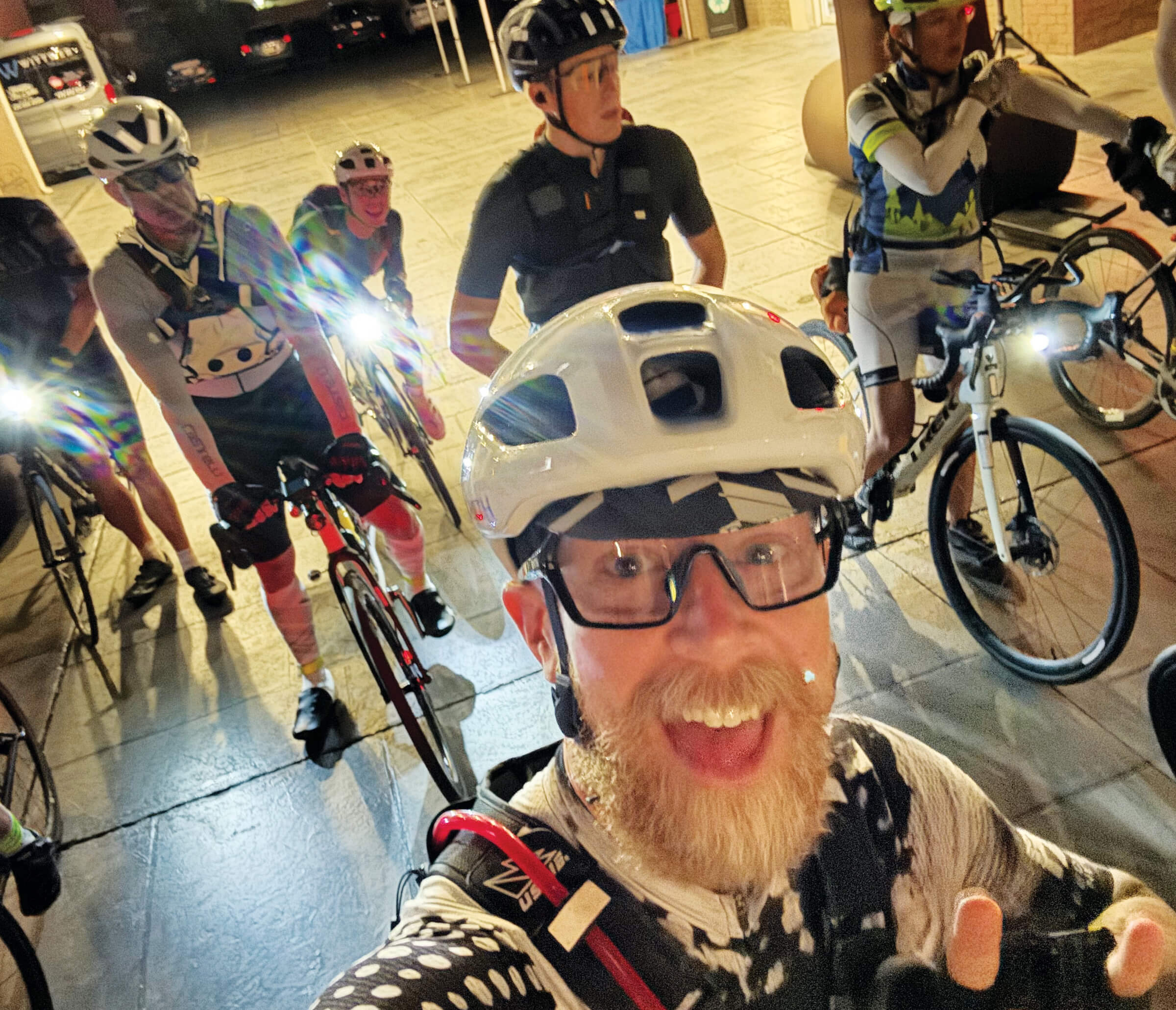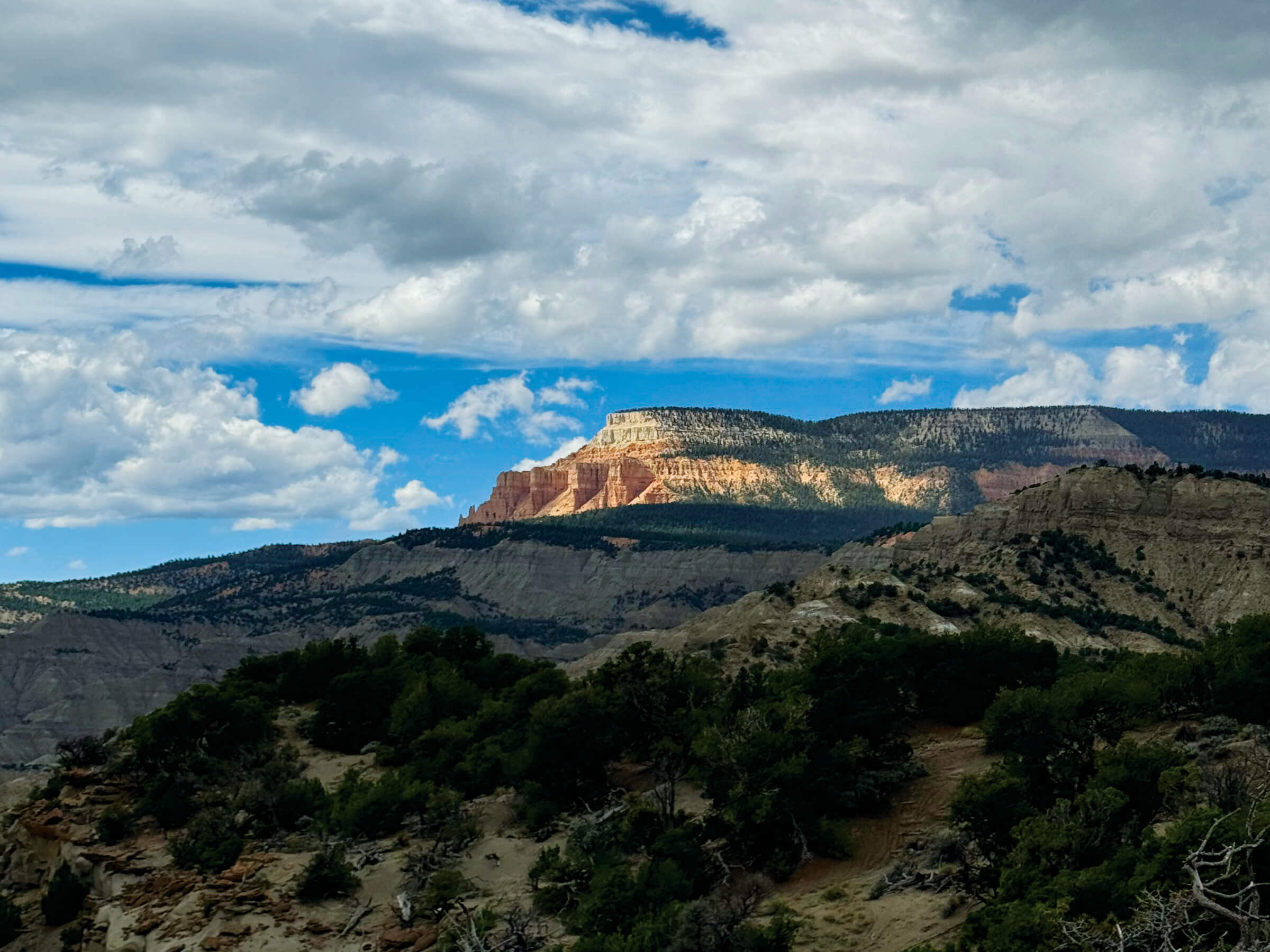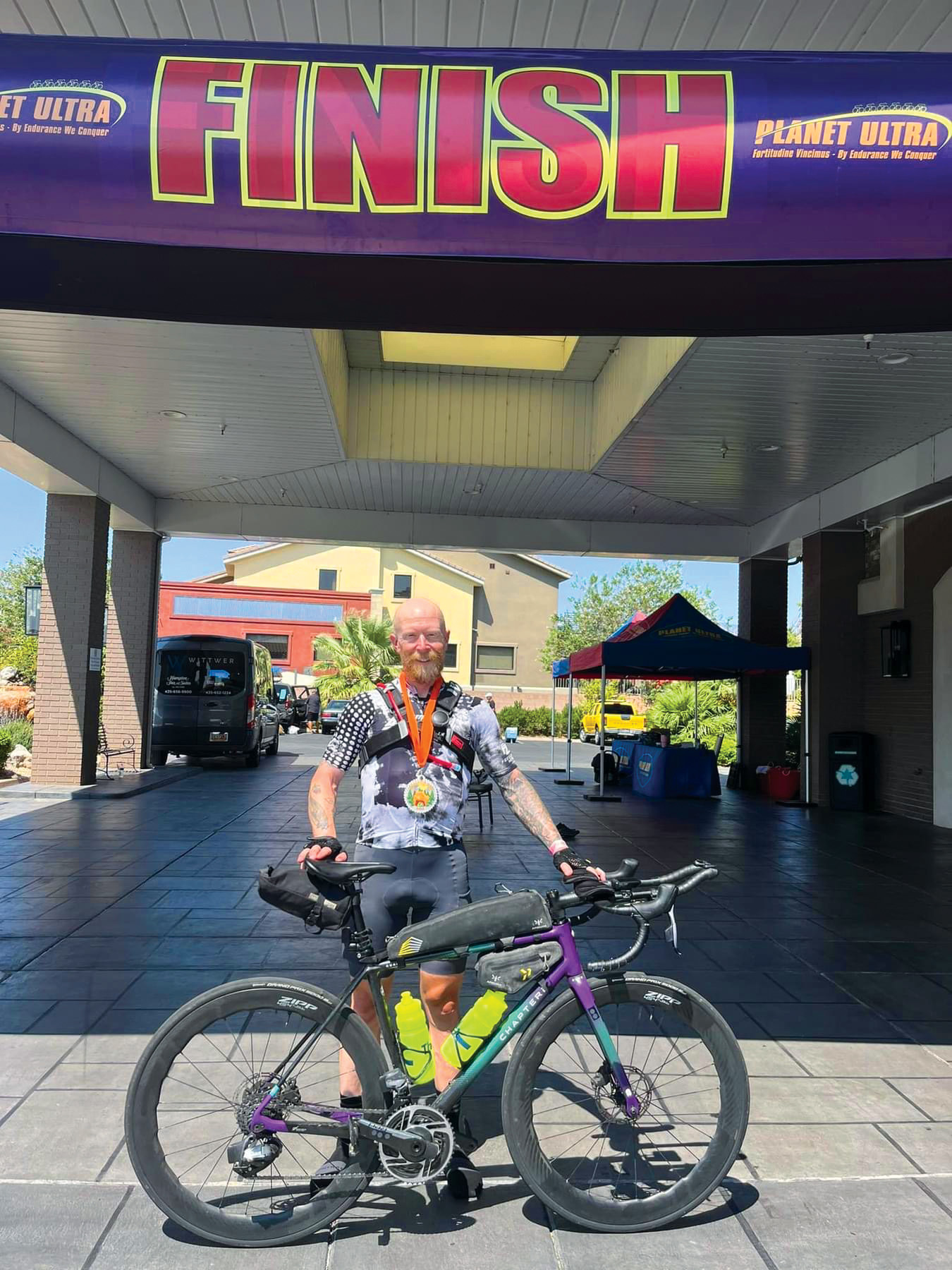Hoodoo 500: Racing around Utah
By Zachary Morvant
It’s the middle of August in Utah and it’s 36°F.
6am, dark, still, and silent on a Sunday. I’m climbing Cedar Breaks National Monument toward Brian Head, over 10,000 feet in the sky, 400 miles and 26 hours into a 520 mile bike race on zero sleep. 265 miles behind me lies the site of a years-old familial tragedy, the most cataclysmic event of my young life.
I focus on keeping my pedal strokes even and breathing controlled in the thin air. I’m wearing almost all of my layers: cycling cap, reflective vest over my jersey and base layer, arm and leg warmers, long finger gloves, shoe covers. If it gets any colder, tucked in one of the many bikepacking bags strapped to my road bike’s frame is my rain jacket. Luckily, despite the threat of monsoonal weather, I haven’t needed it yet.
 The road up Boulder Mountain, one of two above category climbs. Photo: Zachary Morvant / @zmorvant
The road up Boulder Mountain, one of two above category climbs. Photo: Zachary Morvant / @zmorvant
Welcome to the Hoodoo 500.
Just what in tarnation is that, you may ask? (Especially if you’re an old-timey prospector.) The Hoodoo 500 is an ultra-endurance cycling event starting and ending in St. George, Utah. The route is a perfect loop. Their website claims “not a single inch is repeated;” boasts smooth pavement and breathtaking scenery; and goes through, around, or by:
- three National Parks (Zion, Bryce Canyon, and Capitol Reef)
- three National Monuments (Pipe Springs, Grand Staircase-Escalante, and Cedar Breaks)
- and countless Utah State Parks (including Anasazi, Coral Pink Sand Dunes, Kodachrome, and Snow Canyon).
It’s also a RAAM (Race Across America) qualifier, which wasn’t what drew me to it, but I digress.
There are a number of ways you can race it (or “divisions”). You can do the Hoodoo as a relay team. You can do it on a tandem. You can do it solo. All of these are allowed support, which means a minimum of two people that you’ve either paid and/or love you very much. They typically drive a van or similarly large vehicle to hold all the extra gear and have space for sleeping.
But what if you’re frugal, unloved, and/or have a screw loose? Well, my friend, you’re in luck. You can sign up for the Voyager division, aka “self-supported.” I’ll leave it to you to guess what I did.
The rules, like many bikepacking races and randonneur rides, are that you’re allowed no support outside of what’s available to anyone else: meaning you often resupply food and water at gas stations, cafes, and restaurants along the route. If you need mechanical help beyond your abilities, hopefully you can find an open bike shop.
There is, however, an exception from the Hoodoo 500 organizers. Since there are two time stations at hotels along the route (at approximately mile 196 and 368) that involve checking in with a race official, Voyagers are allowed to leave a drop bag at each, as well as use the hotel room facilities for a nap or shower. This is especially helpful because in Utah, everyone seems to go to bed by 9pm and everything is closed, making nighttime resupplies virtually impossible.
Oh, and did I mention that for both the supported and self-supported solo divisions, there is a national championship on the line?
The Voyagers start at least 2 hours earlier than everyone else. So at 5am Saturday, just under 15 of us roll out in darkness from the Best Western in St. George, lights blinking and freehubs whirring. On race organizer Deborah Bowling’s advice, we enjoy the time chatting and getting to know each other a bit, each of us knowing it may be the last lengthy conversation we enjoy for the next 30-50 hours.
 Spirits are high despite the early start for the Voyagers.
Photo: Zachary Morvant / @zmorvant
Spirits are high despite the early start for the Voyagers.
Photo: Zachary Morvant / @zmorvant
There are friendly faces in the field: Clarice Sayle, whom I’ve known from my early fixed gear and road racing days. She’s racing with her partner Jonathan Wilson in the “conjoined” division, which means they have to ride close and finish together. I meet Holly Diop when I comment on her Seattle Randonneurs vest, and of course we have a mutual friend (hi James). Kevin Bilbee, a Hoodoo veteran who’s leading the parade, did the Trans San Gabriel race I bailed on last year due to post-PBP injury concerns. I marvel at how much you can learn about folks in a mere six miles, how small our two-wheeled world is, and then just like that the parade is over and the race is on.
I’ve raced all kinds of mass-start events: road races, track races, hill sprints. This start is not like that. There’s no kick, no immediate fight for position; I simply lower myself onto my aero bars and start slowly pulling away from the field at a pace that would get you dropped in a moderately fast group ride. Everyone here is playing the long game. I am, too — and I also want to set a course record, which currently stands at 35 hours and 24 minutes.
BANG! HISSHISsHIssHisshissss. My most hated sounds in the world right now. It’s only mile 24 and my rear tire just suffered a catastrophic puncture, hemorrhaging air and white tacky tubeless sealant all over my bike and the road. I pull over alongside the parkway, the sky still black, and investigate the massive cut some mystery object inflicted. I stick two Dynaplug darts in it, inflate it with a tiny electric pump, and get rolling, hoping the plugs hold. While I’m doing this, half of the field passes me, but I try not to sweat it. Early yet.
I make it all of two miles before the hissing returns. Pulling over again, I stick a third dart where I feel air escaping, pump it back up, and say a prayer to the bike gods.
The sun comes up, 20 uneventful miles roll by, and there’s that damned snake again. I pull over for the third time in as many hours and stick a fourth dart in my tire, this time inflating to about 75% pressure. Maybe I’ll have to pull all the hardware out and put in a tube and a tire boot. Maybe my day is already over. I get back to pedaling and try not to think about it for the next 460 miles.
The next 60 miles melt away with the risen sun. Relief sets in as I settle into my rhythm, made easier by warm temperatures and a helpful tailwind. I ride through the open range of Coral Pink Sand Dunes State Park, a dozen cattle running alongside me for a magical moment. By mile 100 I regain the lead in my field and reach Orderville, a speck of a town with a population under 600, and my first resupply. I nab a cookie and a protein bar from a gas station and refill my water bottles and hydration pack while overhearing conversations among some real-life cowboys. No “Yellowstone” cosplay or unnecessarily oversized trucks here.
I was 18 years old when my father died. I had just returned from a day at a summer job to find my mom on the landline phone in the living room. Still in conversation, and likely shock, she mouthed the words to me, “your dad is dead.” He had suffered a fatal heart attack while hiking with my younger brother in Bryce Canyon National Park.
23 years and two weeks later, the eerie spires of the hoodoos of Bryce Canyon loom into view. This is the closest I’ve come, and one of the reasons I’m doing this ride: its proximity to something that shook my world to its core, forever altering my path. I feel the pull of the mystical, the spirit realm. I try to imagine the scene: my dad, stout but fit, collapsing in the dust; my 15-year-old brother running for help that comes too late. I try to open my heart to any feelings that pass in and through. I wonder if he’d be proud of who I’ve become. I will never know.
I ride on.
 The eerie hoodoos of Bryce Canyon. Photo: Zachary Morvant / @zmorvant
The eerie hoodoos of Bryce Canyon. Photo: Zachary Morvant / @zmorvant
The Prospector Inn in Escalante is the first crewed time station. I come in hot off an absolutely ripping tailwind and downhill section to meet John, a kind man and Hoodoo veteran who notes my time of arrival, then points me to my drop bag in the hotel room. It’s just before 4pm and despite my tire issues I’m still on record-setting pace, as long as my Dynaplug patch holds up. I take 20 minutes for body maintenance: brushing my teeth, wiping myself down with a cool towel, reapplying sunscreen and chamois cream. Lotions and potions. I add more air to my still slowly leaking tire. My drop bag contains several hours’ worth of bars, gels, and high-carb electrolyte drink mix, which I stuff into pockets and pour into bottles while chatting with John.
Resupply complete, I thank him and bid him farewell before heading down the road toward the one bike shop on the route: the Escalante Cyclery. Maybe they’re open and will have a fresh tire for me.
The good news is they’re open. The bad news is all of their tires are gravel or mountain bike-sized rubber that won’t fit on my road bike. Literally and figuratively deflated, I console myself with a gas station lunch of a ham and cheese sandwich, salty potato chips, and a coke.
I catch a glimpse of a lone racer flying by, followed shortly by a support van: Matthew Lefthand, who seems to be leading the supported solo category. After about 45 minutes total in Escalante, I’m back on the road, headed toward a 3,200 foot climb up Boulder Mountain.
The ascent is beautiful and uneventful. I reach the 9,600 feet summit sign near sundown, donning some layers before the descent, temperature dropping. With my slightly soft rear tire, I’m robbed of the full joy and speed of the downhill, but still make good time. Dinner is just before 9pm at mile 260, a gas station in Torrey: a turkey club wrap, chili cheese corn chips, and a nice sugary energy drink. This will be my last chance to resupply before the hotel at mile 368 in Panguitch.
Riding through the night is rarely easy. It’s one of those things that, to me, relies on the power of proof: you don’t know what you’re capable of until you’ve done it.
With a handful of grueling overnight experiences in my pocket — a few of which were off-road in miserable weather — I enter the night feeling confident. Around midnight, despite a good pace and morale-boosting music from my tiny bluetooth speaker, my energy levels plummet. Some ultra athletes refer to this as “the witching hour.” Everyone has one. Mine usually comes later. But I can’t deny my heavy eyelids and sluggish limbs, and my usual tricks of music and well-timed caffeine are barely working.
Slogging through the darkness, I ponder pulling over and taking out my space blanket for a quick “ditch nap,” but I see no suitable place along these highways. I have to keep going. Maybe I’ll nap at the hotel. Just a few more hours. I slurp a caffeinated gel and soldier on.
Mile 368, sometime after 3:30am, a chain motel in Panguitch. Second in-person checkpoint. Coasting in on fumes, I see numerous crew vans in the parking lot. It’s quiet enough for me to hear the race official, Jen, crack her room’s door open. She sticks her head out and we chat just long enough for her to get my name, record my time, and point me to the room where my second drop bag is.
I’m still on schedule. My rear tire is holding up with periodic refills of air. It’s my body that needs a moment. I go through my maintenance routine again, sacrificing another motel towel to my filth. I decide to try a “nappuccino:” I take a 200mg caffeine pill, then lay down atop the sheets of a bed, closing my eyes.
Less than two minutes later, it’s clear this won’t work. My metabolism is on overdrive, I’m already wide awake and buzzing from the drug. There will be no sleep until I’m done, but my chassis appreciates the nearly one-hour break from riding. I once again fill my pockets full of bike food and my vessels full of liquid, and head out the door to the long, cold climb up to Brian Head.
 Views near the Blues Wilderness Study Area. Photo: Zachary Morvant / @zmorvant
Views near the Blues Wilderness Study Area. Photo: Zachary Morvant / @zmorvant
You already know about the Brian Head summit. Let’s talk about the descent into the desert toward Parowan.
It’s 16 miles long, dropping over 4,500 feet in elevation. It starts with sketchy cross-winds, violent switchbacks, road construction debris, and 13% grades. With my squishy tire and my tired, shivering skeleton, my senses are on high alert. Palpable heat radiates from my brake rotors. I pull over twice to let them cool down.
After a harrowing start to the morning, I’m in the desert, the temperature rapidly climbing. I find a gas station, resupply, and grab a table outside to strip off my extra layers while wolfing down a steak breakfast burrito.
Real food is magic after hours of energy bars, syrup, and salt. With 90 miles to go, I check Trackleaders.com, which shows the location of every rider on a map. (I neglected to mention: primarily for safety reasons, we’re all required to carry small satellite trackers.) The nearest Voyager is over 50 miles behind me. I just have to keep pedaling away, avoid any mishaps, and seal the deal.
It’s easier said than done. Ultra events are masterclasses in “chunking,” the psychological trick of breaking things down into manageable pieces. The remainder of the course is hairdryer-hot headwinds, a handful of close-passing drivers (including one coal roll), and mounting fatigue. I’ll spare you more details but suffice to say I spend an inappropriate amount of time in my aero bars barely going 9mph.
The reward is Snow Canyon State Park. With less than 20 miles to go, a winding descent through gorgeous red rocks buoys my spirits before depositing me on the outskirts of St. George. I pick my way through town, weaving along with meandering Sunday afternoon traffic, climbing one last overpass, the finish line in sight.
33 hours and 16 minutes later — after 520 miles and nearly 30,000 feet of climbing — I’m back where I started. I ride through the arch and the finishing tape, unleash an exultant cry, and collapse on the cement. Deborah comes over and hangs a medal around my neck, congratulating me. I am beyond tired. I am happy. I have a new course record, a World Ultra Cycling Association championship jersey, and an experience to last a lifetime.
This one’s for you, Dad.
 After a brief rest on the pavement, a victory pose. Photo: Deborah Bowling / @planetultra
After a brief rest on the pavement, a victory pose. Photo: Deborah Bowling / @planetultra
Have you or someone you know been involved in a bicycle crash? Want to know about your rights? Are you a lawyer handling a bicycle crash who wants the best result for your client? Contact Bicycle Law at (866) 835-6529 or info@bicyclelaw.com.
Bicycle Law’s lawyers practice law through Coopers LLP, which has lawyers licensed in California, Oregon, and Washington state, and can affiliate with local counsel on bicycle cases across the country to make sure cyclists benefit from cycling-focused lawyers.
